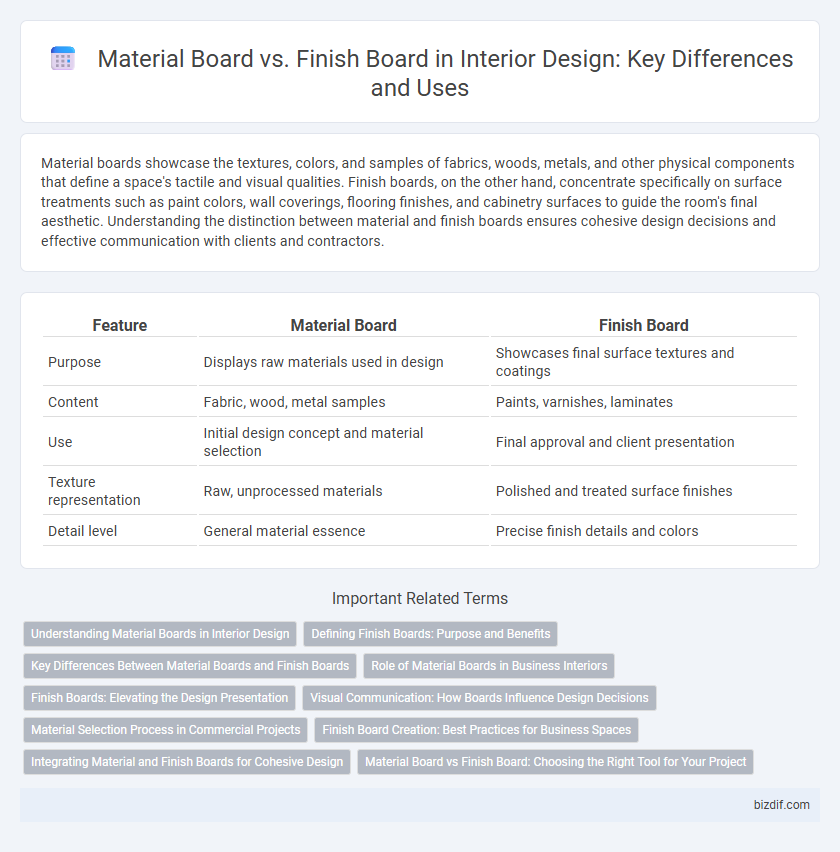Material boards showcase the textures, colors, and samples of fabrics, woods, metals, and other physical components that define a space's tactile and visual qualities. Finish boards, on the other hand, concentrate specifically on surface treatments such as paint colors, wall coverings, flooring finishes, and cabinetry surfaces to guide the room's final aesthetic. Understanding the distinction between material and finish boards ensures cohesive design decisions and effective communication with clients and contractors.
Table of Comparison
| Feature | Material Board | Finish Board |
|---|---|---|
| Purpose | Displays raw materials used in design | Showcases final surface textures and coatings |
| Content | Fabric, wood, metal samples | Paints, varnishes, laminates |
| Use | Initial design concept and material selection | Final approval and client presentation |
| Texture representation | Raw, unprocessed materials | Polished and treated surface finishes |
| Detail level | General material essence | Precise finish details and colors |
Understanding Material Boards in Interior Design
Material boards in interior design serve as comprehensive visual tools that showcase a curated selection of textures, fabrics, and surfaces, helping designers and clients visualize the overall aesthetic. These boards consolidate samples like wood, metal, textiles, and stone to create a cohesive palette that guides the design process from concept to execution. Understanding material boards enhances decision-making by providing tangible references that ensure harmony between colors, finishes, and materials throughout the interior space.
Defining Finish Boards: Purpose and Benefits
Finish boards in interior design serve as detailed visual references showcasing the texture, color, and quality of finishes such as paint, veneer, and sealants used in a project. These boards help designers and clients make informed decisions by providing a true-to-life representation of materials under actual lighting conditions. By clearly defining surface treatments, finish boards enhance communication accuracy and ensure cohesive aesthetic outcomes throughout the design process.
Key Differences Between Material Boards and Finish Boards
Material boards showcase raw construction elements like wood, stone, and fabric samples to represent texture and durability, while finish boards highlight surface treatments such as paint colors, stains, and varnishes that define the final look. Material boards guide the selection of base components, influencing structural and aesthetic decisions, whereas finish boards refine these choices by specifying the exact visual and tactile finishes applied. The key differences lie in their purpose and content: material boards focus on foundational substances, whereas finish boards concentrate on the polished appearance and protective coatings.
Role of Material Boards in Business Interiors
Material boards play a crucial role in business interiors by visually organizing and presenting textures, colors, and subsurface materials that define the space's aesthetic and functional qualities. These boards help clients and designers make informed decisions about fabric selections, wall coverings, flooring, and upholstery to ensure cohesive design language and brand identity. Material boards streamline communication and approval processes while reducing costly errors during implementation in commercial interior projects.
Finish Boards: Elevating the Design Presentation
Finish boards elevate design presentations by providing a detailed, tactile representation of surface materials, including paint colors, fabrics, tiles, and hardware finishes. These boards enable clients and designers to visualize how textures and colors interact in a space, facilitating informed decisions and cohesive design outcomes. Unlike material boards, finish boards emphasize the final aesthetic details and quality, ensuring a polished and professional project presentation.
Visual Communication: How Boards Influence Design Decisions
Material boards showcase textures and tactile qualities, enabling designers to visualize how different materials interact within a space. Finish boards highlight color palettes and surface treatments, guiding choices on paint, fabrics, and finishes that shape a room's aesthetic coherence. Both boards enhance visual communication by providing tangible references that streamline design decisions and client approvals.
Material Selection Process in Commercial Projects
Material boards consolidate samples of fabrics, textures, and finishes to visualize tactile quality and color harmony during the material selection process in commercial interior design projects. Finish boards specifically showcase surface treatments like paint, laminates, and varnishes, emphasizing durability and maintenance suited for high-traffic commercial environments. Both boards streamline decision-making by providing a comprehensive visual and physical reference critical for aligning aesthetic goals with functional requirements.
Finish Board Creation: Best Practices for Business Spaces
Finish board creation for business spaces requires careful selection of durable, high-quality materials that align with brand identity and functionality. Incorporate samples of wall paints, floor finishes, fabrics, and hardware to visualize cohesive aesthetics and ensure consistent application across the project. Prioritize materials that withstand heavy usage and maintain appearance over time, enhancing both design integrity and client satisfaction.
Integrating Material and Finish Boards for Cohesive Design
Integrating material boards and finish boards ensures a cohesive design by aligning textures, colors, and finishes to create a unified aesthetic. Material boards showcase the raw elements such as fabrics, wood, and metals, while finish boards focus on surface treatments like paint, stains, and varnishes, providing a clear visualization of the final look. Combining these boards streamlines decision-making, enhances communication with clients and contractors, and guarantees consistency throughout the interior design process.
Material Board vs Finish Board: Choosing the Right Tool for Your Project
Material boards showcase raw textures and samples such as fabric swatches, wood grains, and stone slabs to provide a tactile understanding of potential project elements. Finish boards compile painted samples, wallpaper patterns, and surface coatings, emphasizing the final aesthetic appearance and durability of materials. Selecting between material boards and finish boards depends on whether the focus is on exploring texture and structural qualities or visual style and protective finishes for interior design projects.
Material Board vs Finish Board Infographic

 bizdif.com
bizdif.com